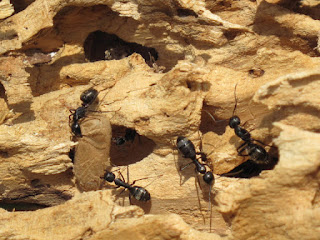Unraveling the Impact of Carpenter Ant Damage: A Guide by Blackwater Consulting Services
Welcome to Blackwater Consulting Services, your premier partner in the Southeastern United States for tackling the intricate challenges posed by wood-destroying pests. With a decade of unwavering commitment to our clients, we specialize in providing expert consulting services, including a comprehensive focus on addressing the significant issues associated with carpenter ant damage. In this blog, we delve into the nuances of Carpenter Ant Damage and Carpenter Ant Wood Damage, shedding light on the complexities and offering insights that go beyond the surface.
Understanding Carpenter Ants and Their Impact
Carpenter ants, often mistaken for termites, are formidable adversaries when it comes to compromising the structural integrity of wooden structures. Unlike termites, carpenter ants don't consume wood for sustenance but excavate it to create nesting galleries. This behavior leads to Carpenter Ant Damage, a concern that goes beyond mere aesthetics and into the realm of potential structural hazards.
Identifying Carpenter Ant Damage
Visual Indicators: One of the first signs of Carpenter Ant Damage is the presence of small openings, or "kick-out" holes, in wooden structures. These openings are where carpenter ants discard debris from their excavations. Additionally, damaged wood may appear smooth and "clean," distinguishing it from the ragged appearance left by termites.
Audible Indications: In some cases, one might hear faint rustling or tapping sounds within walls or wooden structures. These noises can be indicative of carpenter ants at work, causing internal damage that might not be immediately visible.
Frass Accumulation: Carpenter ants produce frass, a mixture of wood shavings, soil, and insect parts, which they expel from their nests. The presence of frass near nesting sites is a telltale sign of Carpenter Ant Wood Damage.
The Extent of Carpenter Ant Wood Damage
Carpenter ants are opportunistic nest builders, often choosing moist or damaged wood to create galleries. The extent of Carpenter Ant Wood Damage can vary based on factors such as the size of the colony, the duration of the infestation, and the type of wood affected.
Structural Weakening: As carpenter ants excavate wood to build their nests, they compromise its structural integrity. Over time, this can lead to weakened beams, joists, and other load-bearing elements.
Property Value Impact: Untreated Carpenter Ant Wood Damage can have a direct impact on property values. The presence of structural damage can make a property less attractive to potential buyers or tenants.
Costly Repairs: Mitigating Carpenter Ant Wood Damage often involves costly repairs. These can include replacing damaged wood, reinforcing structures, and addressing any underlying moisture issues that may have attracted the ants in the first place.
Blackwater Consulting Services: Your Partner in Combatting Carpenter Ant Damage
As a leading consulting service in the Southeastern US, including South Carolina, Blackwater Consulting Services is dedicated to helping clients navigate the challenges posed by wood-destroying pests, particularly carpenter ants.
Expert Testimony: Our seasoned entomologist, Stoney Bachman, provides expert testimony that adds credibility to cases involving Carpenter Ant Damage. His insights go beyond identification, delving into the specifics of the damage caused.
Customized Solutions: Our consulting services are tailored to address the specific challenges presented by Carpenter Ant Wood Damage, offering solutions that align with our clients' needs and objectives.
Holistic Approach: Beyond addressing immediate concerns, we take a holistic approach to consulting. This includes identifying and rectifying conditions that may attract carpenter ants, helping to prevent future infestations.
Preventing Carpenter Ant Damage: A Proactive Approach
While addressing existing Carpenter Ant Damage is crucial, taking a proactive approach to prevention is equally vital. Here are some measures property owners can consider:
Moisture Control: Carpenter ants are attracted to damp or damaged wood. Proper moisture control, including addressing leaks and ensuring adequate ventilation, can make a property less enticing to these pests.
Regular Inspections: Periodic inspections for signs of Carpenter Ant Damage, especially in vulnerable areas like attics, basements, and crawl spaces, can help detect and address issues early on.
Prompt Intervention: If Carpenter Ant Damage is suspected, seeking professional consulting services promptly is essential. Early intervention can minimize the extent of the damage and the associated repair costs.
Conclusion: Empowering Property Owners Against Carpenter Ant Damage
In the face of Carpenter Ant Damage, knowledge
is power. At Blackwater Consulting Services, we empower property owners in the
Southeastern US with the insights and expertise needed to tackle the
complexities of carpenter ant infestations. From expert testimony to customized
solutions, our consulting services go beyond addressing immediate concerns,
aiming to fortify properties against future threats. Contact us today to
explore how our seasoned entomologist and holistic consulting approach can be
your key allies in combatting Carpenter Ant Wood Damage and preserving
the structural integrity of your property. Trust Blackwater Consulting Services
to be your partner in navigating the intricate world of wood

.jpg)
Comments
Post a Comment